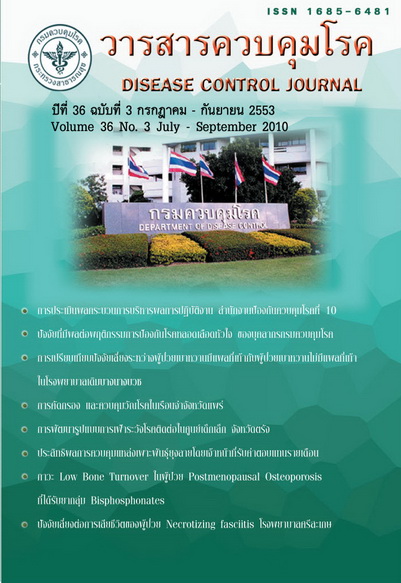Predictors of Mortality in Necrotizing fasciitis in Sisaket Hospital
Keywords:
Necrotizing fasciitis, mortality, risk factor, Srisaket HospitalAbstract
Necrotizing fasciitis could progress rapidly in soft tissue infection and it was potentially lifethreatening with high mortality rate (10-20%) in Sisaket Hospital. The aim of this study was to identify predictors of mortality based on data available at the initial assessment to stratify prognosis of the according to their risk of death. This was a Retrospective study of 314 patients admitted with necrotizing fasciitis in Sisaket Hospital during 1 January 2008 - 31 January 2010. Patients were separated into 2 groups; Group I : 42 non-survived patients and Group II : 272 survived patients. This study used t-test for continuous variables and then the chi-square test was used to identify variables strongly associated with death. This research revealed the following factors are associated with mortality : Metabolic acidosis; tachycardia; hypotension(p<0.05), higher creatinine(p<0.001), Age>70(OR=2.5, 95%CI=1.3-4.9), site of infection (upper extremity(OR=3.5, 95%CI=1.54-8.17) and perineum(OR=6.7, 95%CI= 0.93-49.27)),body temperature<36.5 c(OR=16.5,95%CI=6.3-42.7), Hct<30(OR=2.0, 95%CI=1.06-3.94), WBC<4000(OR=17.9, 95%CI=4.4-72.5), platelete<100,000(OR=5.4,95%CI= 2.1-13.6), asso ciated condition of CRF(OR=3.88, 95%CI=1.7-5.0), Scr>2.0(OR=12.4, 95%CI=5.6-27.3) and HCO3<20(OR=7.6, 95%CI=3.6-16.3). This study demonstated that site of infection(upper extremity, perineum), hypotension, shock, hypothermia, anemia, leucopenia, thrombocytopenia, metabolic acidosis and associated condition of chronic renal failure were significant risk factor for mortality in necrotizing fasciitis patients.
Downloads
References
2. Freischlag JA, Ajalat G, Busuttil RW. Treatment of necrotizing soft tissue infections, Am J Surg 1985; 149: 751-55.
3. Faucher LD, Morris SE, Edelman LS, Saffle JR. Burn center management of necrotizing sort-tissue surgical infections in unburned patients. Am J Surg 2001; 182: 563-9.
4. Lille ST, Sato TT, Engrav LH et al. Necrotizing soft tissue infections: Obstacles in diagnosis. J Am Coll Surg 1996; 182: 7-11.
5. Anaya DA, Bulger EM, Kwon YS, et al. Predicting Death in Necrotizing Soft Tissue Infections: A Clinical Score. Surgical Infections 2009; 10: 517-22.
6.Bair MJ, Chi H, Wang WS, et al. Necrotizing fasciitis in southeast Taiwan: clinical features, microbiology, and prognosis. Int J Infect Dis. 2009; 13(2): 255-60.
7. Aragon-Sanchez J, Hernandez-Herrero MJ, Lazaro-Martinez JL, et al. In-hospital complications and mortality following major lower extremity amputations in a series of predominantly diabetic patients. Int J Low Extrem Wounds 2010; 9(1): 16-23.
8. Martin DA, Nanci GN, Marlowe SI, et al. Necrotizing fasciitis with no mortality or limb loss. Am Surg 2008; 74(9): 809-12.
Downloads
Published
How to Cite
Issue
Section
License
Articles published in the Disease Control Journal are considered as academic work, research or analysis of the personal opinion of the authors, not the opinion of the Thailand Department of Disease Control or editorial team. The authors must be responsible for their articles.






